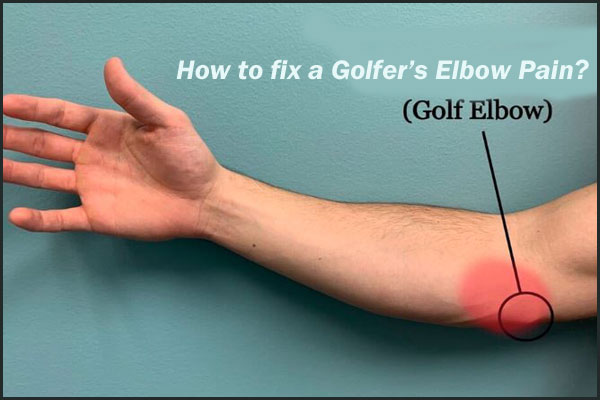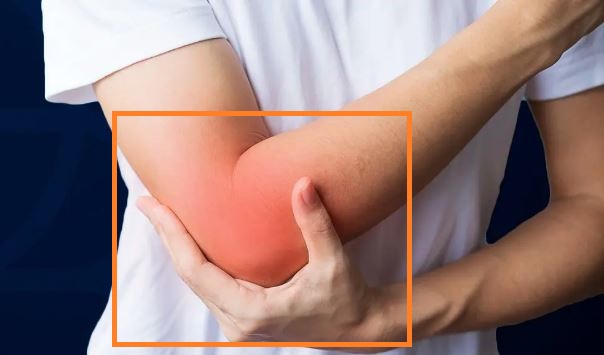Golfer’s elbow, or medial epicondylitis, is a common overuse injury characterized by pain on the inside of the elbow. This guide will provide a step-by-step approach to how to fix a Golfer’s elbow pain fast, along with treatment, and problem-solving tips.
While it’s often associated with golfers, it can affect anyone who performs repetitive wrist and arm motions. There are effective methods to alleviate pain and promote healing.

Step-by-Step Guide on How to Fix a Golfer’s Elbow Pain Fast
1. Rest and Reduce Activity
- Avoid Aggravating Activities: Limit activities that involve repetitive wrist and forearm motions. If you’re a golfer, consider taking a break from the sport.
- Use Ice: Apply an ice pack to the affected area for 15-20 minutes every few hours to reduce inflammation.
2. Modify Your Technique
- Assess Your Grip: If you play golf or engage in other sports, ensure your grip is not too tight. A relaxed grip can reduce strain on the elbow.
- Consider Equipment: Use equipment that suits your strength and skill level. For golfers, lighter clubs or those with a larger grip can help.
3. Stretch and Strengthen
- Gentle Stretches: Perform wrist flexor stretches by extending your arm in front, palm up, and gently pulling back on your fingers with the other hand.
- Strengthening Exercises: Once pain subsides, focus on strengthening your forearm muscles. Exercises like wrist curls, reverse wrist curls, and grip squeezes can help.
4. Use a Brace or Support
- Forearm Brace: Consider wearing a forearm brace or a compression sleeve to provide support and reduce strain on the elbow during daily activities.
- Proper Ergonomics: Adjust your workspace to minimize strain on your elbows, such as using an ergonomic keyboard.
5. Consider Professional Help
- Physical Therapy: A physical therapist can create a personalized rehabilitation plan, focusing on stretching and strengthening exercises tailored to your needs.
- Consult a Doctor: If pain persists for more than a few weeks, consult a healthcare professional to rule out more serious conditions and discuss treatment options.
6. Gradual Return to Activity
- Ease Back In: When returning to your sport or activity, gradually increase intensity and duration. Avoid sudden movements that could re-aggravate the elbow.
- Listen to Your Body: Pay attention to pain signals. If discomfort returns, scale back your activities and reassess your approach.
Problem-Solving Tips on how to fix golfer’s elbow pain
- Persistent Pain: If you follow the recommended steps for pain, it may indicate a more serious injury. I’d like to point out that seeking professional evaluation is crucial.
- Inconsistent Relief: If symptoms fluctuate, keep a diary to track activities and pain levels. This can help identify triggers and adjust your approach.
- Difficulty with Exercises: If certain exercises cause pain, modify them. For example, reduce weight o, or focus on gentler stretches.
- Psychological Factors: Chronic pain can sometimes lead to frustration or anxiety. Incorporating relaxation techniques, like mindfulness or gentle yoga, may help improve your overall well-being.
Read also more related topics: Can You Use a Golf Umbrella in the Rain?
How to drive a golf ball farther?
Are Golf Courses Measured in Feet or Yards?
Removal Treatment for Golfer’s Elbow Pain
The exercises may be recommended for a specific condition or for rehabilitation purposes. Initiate each exercise at a slow pace.
Reduce the intensity of the exercises if you experience any pain. Just so you know, you will receive instructions on when to begin these exercises and which ones are most suitable for your needs.
1. Treatment
Initiate treatment by refraining from activities that trigger pain. Ice can be used to alleviate pain.
2. Medication
You have the option to use non-prescription painkillers such as ibuprofen (Advil, Motrin IB, others), naproxen sodium (Aleve), or acetaminophen (Tylenol, others). Corticosteroid injections are not frequently administered due to limited long-term efficacy.
An emerging treatment under exploration is platelet-rich plasma therapy, which includes extracting a small sample of your blood and injecting a concentrated mixture of platelets and other anti-inflammatory components into the affected region. Further research is required to assess the efficacy of this approach.
3. Therapy of that pain
Please attempt the following:

- Take a break. Pause your golf game or any repetitive activities until the pain subsides. Resuming activity too early can exacerbate your condition.
- Apply ice to the impacted area. Use ice packs on your elbow for 15 to 20 minutes, three to four times daily for a few days. Wrap the ice packs in a thin towel to prevent skin damage. Consider massaging the inner elbow with ice for five minutes, two to three times daily.
- Utilize a brace. Your physician may suggest wearing a counterforce brace on your injured arm to help alleviate tendon and muscle strain.
- Stretch and strengthen the impacted region. Your physician may recommend exercises to stretch and build strength. Introducing gradual resistance to the tendon through targeted strength training workouts has proven to be highly beneficial. Occupational therapy techniques may also assist.
Gradually resume your normal activities. Once the pain subsides, engage in the arm movements associated with your sport or activity. Seek guidance from a coach to assess and refine your golf or tennis swing, adjusting as necessary.
4. Surgery
Surgery is rarely required, but if conservative treatments do not work within six to 12 months, surgery could be considered. The TENEX procedure is a minimally invasive method that uses ultrasound to eliminate scar tissue near the painful tendon area. Further research is necessary.
Rest, ice, and pain medication can help most individuals recover. Pain may persist for an extended period despite following treatment recommendations. the pain may recur or become chronic.
FAQs on how to fix golfers’ elbow
What causes the golfer’s elbow?
Golfer’s elbow is caused by repetitive stress on the wrist and forearm muscles, leading to small tears in the tendons at the elbow.
How long does it take to heal?
Healing time varies depending on the severity of the condition. Mild cases may improve in a few weeks, while more severe cases may take several months.
How to fix medial epicondylitis?
To fix medial epicondylitis (golfer’s elbow), start with these steps:
- Rest: Avoid activities that aggravate the elbow.
- Ice: Apply ice for 15-20 minutes several times a day to reduce inflammation.
- Pain Relief: Use over-the-counter NSAIDs like ibuprofen for pain management.
- Gentle Stretching: Perform wrist flexor stretches to improve flexibility.
- Support: Wear a forearm brace to relieve strain during activities.
- Gradual Return: Slowly reintroduce activities, focusing on proper technique and grip.
If symptoms persist, consult a healthcare professional for further evaluation and treatment options
Can I still play golf with a golfer’s elbow?
It’s advisable to take a break from golf until the pain subsides. When you return, consider using a lighter club and modify your grip.
Are there any medications I can take for the pain?
Over-the-counter pain relievers, like ibuprofen or acetaminophen, can help reduce pain and inflammation. Always consult with a healthcare provider before starting any medication.
How can I fix my tennis elbow?
To fix tennis elbow (lateral epicondylitis), try these steps:
- Rest: Avoid activities that strain the elbow.
- Ice Therapy: Apply ice packs for 15-20 minutes several times daily to reduce swelling.
- Pain Relief: Take over-the-counter NSAIDs like ibuprofen for pain and inflammation.
- Stretching and Strengthening: Engage in wrist extensor stretches to enhance flexibility and provide support.
- Brace Support: Use a forearm brace to alleviate pressure during daily tasks.
- Modify Activities: Adjust your grip and technique in sports or repetitive tasks.
If pain persists after a few weeks, consult a healthcare professional for tailored advice.
Last Word
A golfer’s elbow can be a frustrating condition, but with the right approach, recovery is achievable. By following this step-by-step guide, and seeking professional assistance when necessary to your activities, you can effectively manage and overcome the golfer’s elbow pain. Remember, patience and consistency are key to your recovery journey!
